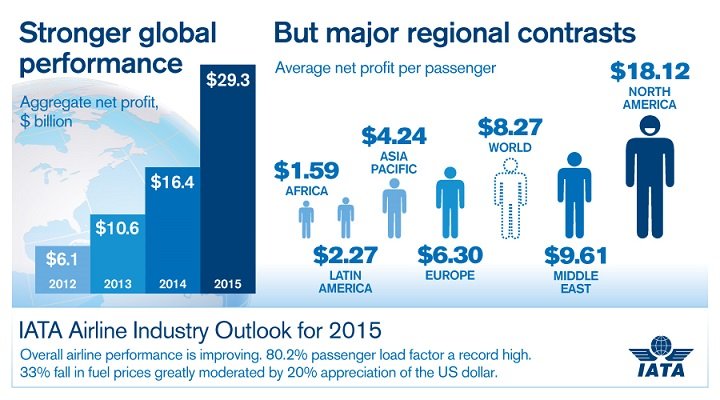Global airlines are expected to record a collective $29.3 billion net profit this year, according to a new forecast from the International Air Transport Association (IATA).
With returns exceeding the cost of capital for the first time in the industry’s history as a result of a fall in oil price, lower bond yields and carriers filling more of their seats, the outlook is up from the December forecast of a $25 billion profit.
Over half of the global profit is expected to be generated by airlines based in North America, with collective earnings of $15.7 billion. Asia-Pacific carriers are forecasted to collect earnings of $5.1 billion as a weaker cargo market and slowing growth in China leads to a more mixed performance.
“The industry’s fortunes are far from uniform. Many airlines still face huge challenges,” said Tony Tyler, IATA’s Director General and CEO.
The industry grouping saw the fuel bill decreasing to $191 billion from $226 billion in 2014, and at the same time, planes are expected to fly fuller than ever before as the industry continues to match capacity more closely to demand.
“For the airline business, 2015 is turning out to be a positive year. Since the tragic events of September 2001, the global airline industry has transformed itself with major gains in efficiency. This is clearly evident in the expected record high passenger load factor of 80.2% for this year,” added Mr Tyler.
European airlines are expected to post a collective profit of $5.8 billion in 2015, with network airlines serving the North Atlantic continuing to generate moderate returns. Middle Eastern airlines are expected to post a collective $1,8 billion net return for the year, with the regions carriers expected to see a 12.9 percent increase in passenger numbers.

IATA's chief Tyler also said at the meeting that air travel was safer than ever despite a series of headline-grabbing airline disasters in recent months. "With one jet hull loss for every 4.4 million flights last year, flying has never been safer," he said.
IATA has advocated for an even deeper partnership with governments based on global standards in the critical areas of safety, infrastructure, security, regulation and environment.
“Aviation is built on partnerships and the relationship with governments is key. Airlines and governments are well-aligned on safety. But in other areas of government responsibility—infrastructure, security, regulation, and environment—there are opportunities for a deeper partnership,” Mr Tyler added.
Up to 3.5 billion people and 55 million tonnes of cargo will travel safely by air over a global network of 51,000 routes, and for nations, connectivity is much more than a competitive advantage – it is an economic necessity.
According to Tony Tyler, there is a tremendous common interest with governments to support safe, efficient and sustainable global connectivity that only air transport can provide.
Aviation can only deliver its significant social and economic benefits if it has adequate, cost-efficient infrastructure capacity to meet growing demand. “We seek to work in partnership with governments based on the global principles that they have agreed through ICAO. Transparency and consultation will ensure that what is built matches business needs at a price that is affordable and mutually beneficial,” said Tyler.
He noted a number of critical infrastructure challenges where more alignment is needed. Such as the capacity problem in the Southeast of the UK, addressing the high fuel costs in Brazil and Africa, and keeping costs at Hong Kong International Airport competitive as it funds the construction of third runway.
“We must join forces to encourage governments to align on a risk-based approach, adopt global best practices, recognize equivalent measures by other governments, stop wasteful and paper-based processes, and make full use of available technology,” he added.